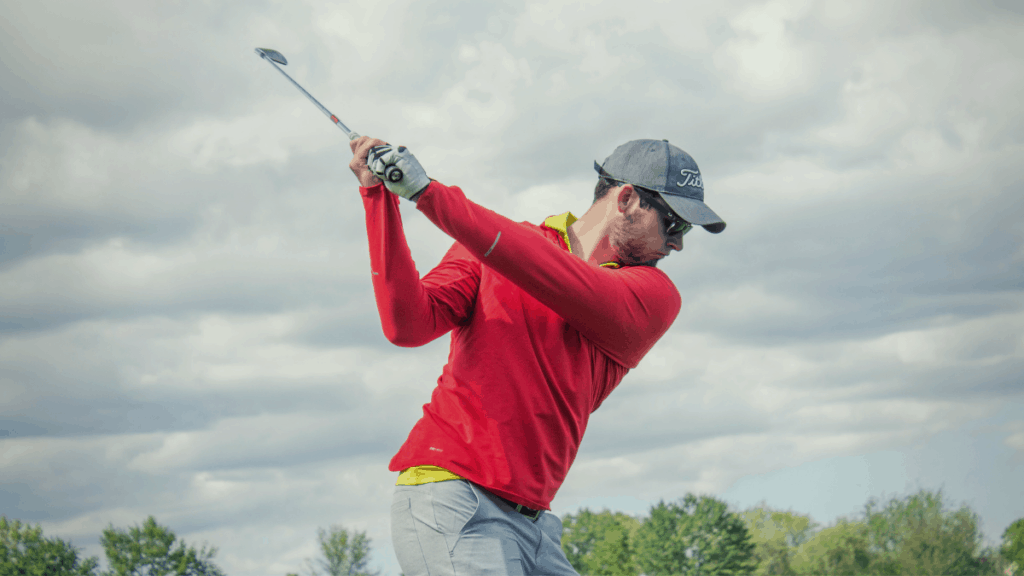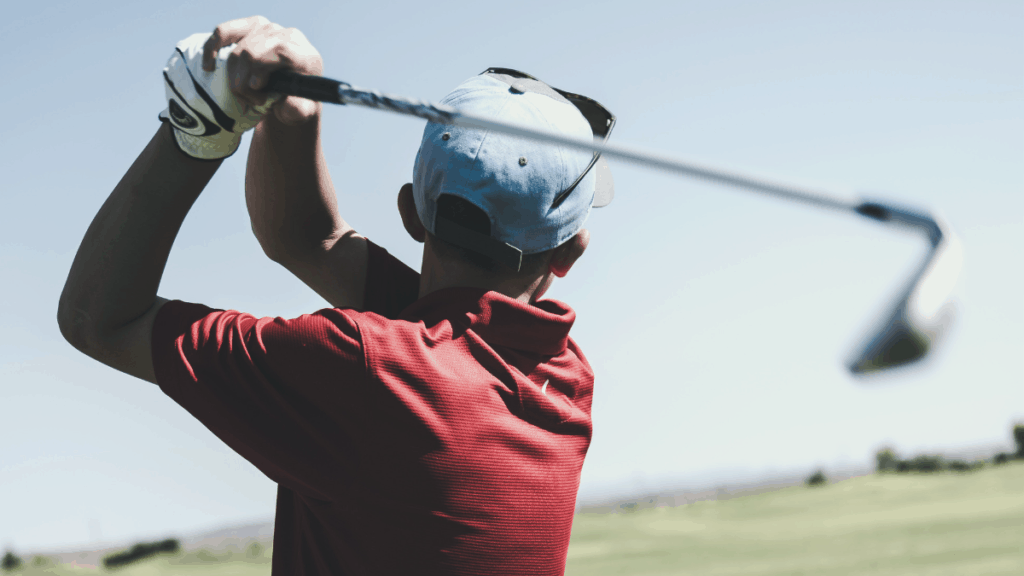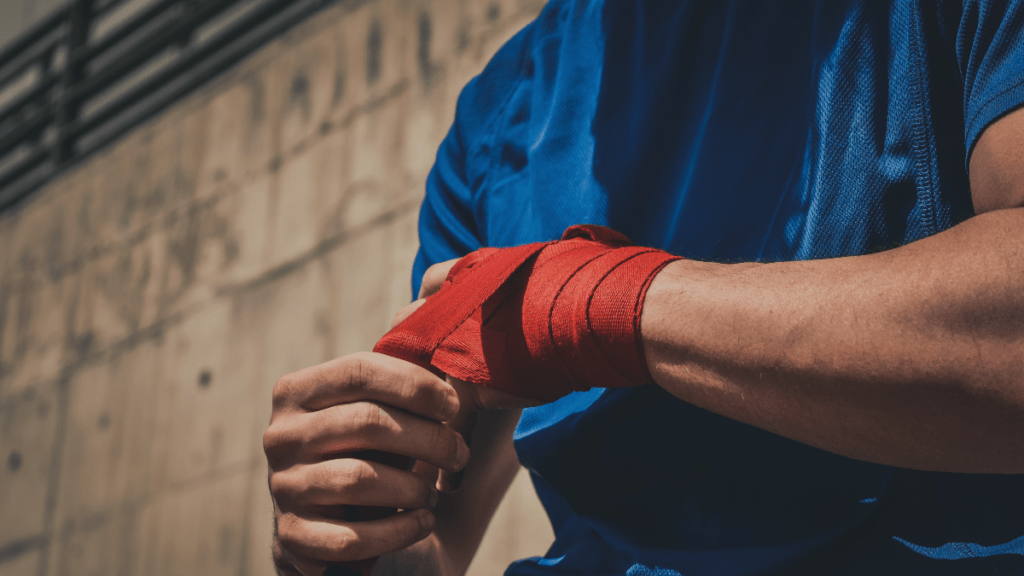Many people consider golf a low-risk sport for physical activity. However, there are many ailments that can be caused by golfing.
Golfer’s elbow is one the most common golfer’s condition.
According to the US Consumer Product Safety Commission (CPSC), in 2015, over 131,000 people were treated for golf-related injuries in hospital emergency rooms, doctors offices, and clinics. (12)
Whether you are at risk of getting golfer’s elbow, or currently suffer from it, you may want to learn more about it. This definitive guide will help you deal with this common golfer’s condition.
What is Golfer’s Elbow
Golfer’s elbow (medial epicondylitis) is the tearing or pulling of the tendon on the inside of your lower arm near the elbow. The tearing or pulling can cause pain and discomfort.
The part of your muscle that attaches to the bone is called a tendon. These tough bands of connective tissue are what allow you to have flexion (bending) and extension (stretching) in your arm. They also assist in supination (palm up) and pronation (palm down) movements. (10)
Tendons are tough, fibrous and capable of withstanding tension. However, overuse of these tendons can lead to small tears. Over time this causes inflammation in the elbow joint region. An inflamed tendon is more likely to get ruptured.
Symptoms of Golfer’s Elbow
You may be wondering if you have the condition commonly known as golfer’s elbow. Many conditions have similar symptoms, all with unique treatment processes. It is best to decide beforehand what injury you have before any treatment is begun.
For example, many people confuse tennis elbow for golfer’s elbow. These two ailments are considered ‘cousins.’ They are very similar. However, tennis elbow stems from damage of tendons on the outside of the elbow. Golfer’s elbow is caused by tendons on the inside. (3) Both are a form of tendinitis and are caused by similar things.
Today we are going to talk about some of the symptoms that are associated with golfer’s elbow. If you suffer from golfer’s elbow, you may likely experience one or more of these symptoms.
See a doctor if you are unsure about what your condition could be. There are several ways that your doctor can diagnose your pain so that you can better decide on the right treatment for you.
Your general practitioner will diagnose you with golfer’s elbow based on a simple physical examination. Occasionally, further tests may be required. These tests can include an x-ray which detects calcium buildup on and around the tendon. Ultrasounds or an MRI can be used to reveal swelling of the tendon sheath. (1)
Pain
You may experience pain or tenderness in your wrist, elbow, and forearm if you suffer from golfer’s elbow. (6) Pain starts in the middle of the elbow and radiates down the wrist. It is rare someone with golfer’s elbow will feel pain in the actual elbow.
Pain from golfer’s elbow can come on gradually, over time, or appear suddenly. Golfer’s elbow is usually brought on by repetitive movements over a period, but it is possible to tear your tendon with one motion as well.
If you have golfer’s elbow, your symptoms are likely to worsen when you complete the following tasks among others.
- Turning a doorknob
- Squeezing a ball or making a fist
- Flex your wrist
- Shake hands
- Weightlifting
Swelling
The tiny tears and pulls in the tendon become inflamed and can cause redness and swelling. The affected area may also seem hot to the touch.
Swelling is your body’s natural response to any injury. You may notice swelling around your injured arm for the first 2–3 days of an incident. If you suffer from chronic swelling or swelling and redness lasts longer than 2-3 weeks, you should see your doctor.
Numbness
Another common sensation associated with medial epicondylitis is numbness. Some people who suffer from golfer’s elbow complain about a tingling feeling shooting down their fingers. The fingers most affected are the little finger and ring finger. (6)
The ulnar nerve runs down the back of the prominent bone on the inside of your elbow (medial epicondyle) all the way to your fingers. (9) If that nerve is irritated from golfer’s elbow, your fingers will begin to feel numb.
Other Symptoms
Weakness in hands especially when gripping. You may not be able to preform tasks that were simple before your injury. For example, opening a bottle or riding a motorcycle can become a major chore.
Cracking or grating sensation when moved. This sensation is caused by the added buildup of new scar tissue. Essentially you are breaking up the buildup slightly with each movement.
A tiny lump that develops along the tendon can be felt. In most cases, you will not be able to see the lump through the skin.
If a tendon has been ruptured, you will experience intense pain. Movement will be very difficult and uncomfortable. One sign your doctor will look for is a gap in the tendon. It can easily be felt by running your finger along the tendon.

Causes of Golfer’s Elbow
Now that we have determined whether or not what you have is golfer’s elbow, we can dive into what causes it. Learning what causes your symptoms can be one of the best ways to resolve the issue.
Golfer’s elbow is commonly seen in golfer’s, hence the name, but let’s see why.
Repetitive Movements
The main reason people get golfer’s elbow is because of repetitive motions. Each time you move your wrist or elbow, you are pulling at your tendon. Doing this, again and again, will cause tearing of the tendon.
Repeated stress on the muscle and tendon from poor conditioning, improper lifting, or too little warm-up can cause golfer’s elbow. Poor technique or use of the wrong equipment can condition your muscles to move improperly.
Trauma
While repetitive motions are the leading cause of golfer’s elbow, trauma is another factor. Sudden injuries such as over-extension can tear the tendon, giving you medial epicondylitis.
Any activity that leads to a forceful extension of the elbow puts you at a higher risk of getting golfer’s elbow. When golfing, you sometimes extend your elbow beyond its physiological range.
Direct trauma such as a fall, car accident or work related injury can also be cause for golfer’s elbow.
Unexpected Causes
A lot of people are surprised to learn that they may have a condition called golfer’s elbow, when in fact, they don’t golf. There are many ways you can be afflicted with medial epicondylitis.
Any activity that requires repeated bending and straightening of your elbow can leave you at risk for golfer’s elbow. Some other activities that commonly cause golfer’s elbow include:
- Bowling
- Baseball (specifically pitching)
- Painting
- Raking
- Using a computer
- Use of tools such as hammers and screwdrivers
Note: Performing these activities over 1 hour a day, spanned over a long period of days, can cause golfer’s elbow.

Risks of Golfer’s Elbow
Even though golfer’s elbow is a short term problem and can usually be cured with rest, it can mean more serious problems in the long run.
Symptoms that last longer than three months can take longer to heal. Tendons are harder to heal because your muscles begin to learn how to move improperly. This movement becomes habitual and hard to break over time. (5)
If left untreated your golfer’s elbow can have adverse effects including:
- Longer healing times
- Joint stiffness
- Abnormal scar tissue
- Muscle weakness
Untreated or mistreated medial epicondylitis can be more susceptible to a ruptured tendon. Ruptured tendons may require surgery to fix.

Preventing Golfer’s Elbow
There are many preventive measures that you can take if you suspect that you may be at risk for golfer’s elbow.
If you spend more than an hour a day doing repetitive exercises bending your elbow, you may want to take precautions against this painful ailment.
Some of the most affected professions are:
- Painters
- Plumbers
- Construction Workers
- Cooks
- Assembly-Line Workers
- Computer Users
- Butchers
Of course, if your hobby or profession includes golf, bowling, fishing, or baseball, you may be at risk as well. Consider adding some of these preventive measures into your routine.
Strength Exercises
Bulking up your muscles is a great way to prevent golfer’s elbow. Doing these exercises will train your tendon the proper way to move. Over time you will be strengthened and increase your flexibility.
If you currently have tendinitis or golfer’s elbow, you should wait until you are fully recovered to begin any strengthening exercises. Doing strength exercises while injured can cause more damage and prolong the healing process.
Some exercises that specifically work the muscles associated with golfer’s elbow are listed below. (11) If you suffer from golfer’s elbow or are at risk, you might want to introduce these simple tasks into your daily routine.
- Grip Strengthening. Squeeze a soft rubber ball. Hold the squeeze for 5 seconds and release. Do two sets of 15 daily.
- Wrist Flexion. Start by resting your arm on a flat surface holding a 1-liter bottle of water. Curl the weight up and down, keeping your forearm and wrist still. Do three sets of 10 daily. When this becomes easier, you can increase it to three sets of 30.
- Static Exercises. Begin by resting your forearm on a flat surface with your palm facing upwards. Use the other hand to resist as you flex your wrist. There should be no movement at the wrist.
- Start with 30 percent of your maximum effort. Hold the contraction for 5-10 seconds. Give it a rest and repeat 5-10 times.
Take care not to overdo any exercise. Otherwise, it could have the reverse effect you are looking to accomplish.
Switch it Up
Changing your routine a bit helps you avoid the repetitive motions that are associated with golfer’s elbow. This may take some time to get used to. However, it could save you some pain down the line.
Switching up your routine can assist in preventing medial epicondylitis because by giving your muscles a rest. Giving your tendons time to heal properly before overuse is a good idea. It will not only prevent you from getting golfer’s elbow but also strengthen your tendon as well.
One of the best ways to prevent golfer’s elbow when practicing a sport such as golf is to take several days off. As this may not always be possible, you can also give your arms rest by trying different swings.
People who suffer from golfer’s elbow through work-related injuries may find ways to work on several tasks throughout the day to work different parts of your body.
If you find that you are feeling pain after a prolonged movement, changing up your routine is especially important.

Invest in a Brace
An elbow brace is very effective when it comes to the prevention of golfer’s elbow. It works by dissipating the stressful gripping forces away from your elbow. (4)
Even if a brace is labeled for tennis elbow, it can still help with the prevention of your golfer’s elbow. This is because tennis elbow and golfer’s elbow are similar in many ways. The only difference between the two is the side of the forearm the hurt tendon is on. (3)
Stretch Before
Stretching will prepare your muscles for a repetitive motion. Doing stretching exercises before beginning any activities that could cause golfer’s elbow is a good idea. Warm your muscles up in preparation for rigorous exercise.
Avoid elbow problems by reducing the shock to your muscles and tendons. Try some of these stretching exercises to prevent golfer’s elbow before your work out.
- Reverse Wrist Curls. Using a lightweight dumbbell, place your hand in front of you palm down. Use your wrist to lift the weight up and down. Limit the motion in your forearm by holding it down with your other arm. Complete 10 repetitions of this exercise with each arm.
- Neutral Stretch. Begin by lying on the ground or a flat surface. Roll to your side with your elbow extended past your head. Place your palm on your neck facing upwards and stretch.
- Hold this stretch for 5 seconds and repeat 5-10 times. Repeat with your other arm.
- Wrist Flexor Stretch. Do this exercise by sitting or standing. Hold your arms stretched out in front of you. Extend your arm as far out in front of you as possible with your palm facing away from you. With your other arm, pull your fingers backward lightly. This should not cause any pain.
- Hold this position for 30 seconds. Repeat this exercise 5 times with each arm. Rotate each arm in between repetitions.
Remember not to overdo any exercises, as they may have the opposite effect you are looking to achieve. These stretching exercises are designed simply to warm your muscles up, not provide strengthening.
Golfer’s Elbow Treatments
Anyone that suffers from golfer’s elbow knows just how frustrating it can be. There are a variety of treatment options available to fit your needs. Some of these treatment options are good for relieving symptoms such as pain and others work to restore your tendon function.
Whether your golfer’s elbow was caused by one over-extension or by a repetitive motion over a long period, treatment is best when caught early on. Begin treatment as soon as you notice symptoms of golfer’s elbow for a quicker healing time.
It is suggested you speak with your doctor before initiating any medical treatment.
Rest
One of the best things you can do post-injury is give it a rest. Immediately stop any activity that caused the initial injury. If you are unable to completely stop the activities that caused your golfer’s elbow, a significant reduction of the activity should be implemented. (2)
Any activities that cause you pain should also be reduced. If you notice any discomfort preforming activities such as typing or lifting items a certain way, it should be avoided if possible.
Only when your pain lessens to a 2 out of 10 should you introduce those actions back into your routine. Take caution to not overdo it, especially within the first several days of initial injury. (7)
Hot/ Cold Treatments
Icing your injury is recommended for the first several days to help reduce swelling and calm inflammation. Apply an ice pack to your affected area for 7-10 minutes throughout the day. You should allow at least an hour in between applications. Ice can help reduce pain associated with tendon injuries.
Once the swelling is visibly removed from the area, you can apply a hot pack. Adding an element of heat to your injury will promote blood flow. Heat from a hot pack or warm cloth can also relax your muscle and lessen your pain.
Note: It is not recommended to apply heat to any injury in the first 48hours. This includes heat rubs as well.
Pain Relievers
When looking for pain relief in the form of medicine, try to find something with an anti-inflammatory as well. Pain relievers such as Ibuprofen have been known to help alleviate symptoms associated with medial epicondylitis.
If you suffer from asthma, kidney disease, or liver disease, you should not take any NSAIDs (non-steroid anti-inflammatory drugs). Consult the packaging for correct dosage before taking any medication.
Compressive Bandages
Compressive bandages are helpful when it comes to early treatment of medial epicondylitis for several reasons. It is recommended that you use a compression bandage or other form of support as soon as you notice the pain. (5)
- Reduces swelling associated with your injury
- Trains your muscles and tendons to move in the correct way
- Promotes growth of new scar tissue in proper place
- Give you support to prevent further injury
Elevation
Elevating your injury over the first several days you notice pain can help relieve symptoms. Resting your injury above your heart will allow gravity to do its work. Swelling will gravitate to its lowest point. (5)
Steroid Injections
For immediate symptom relief contact your doctor about corticosteroid injections. Steroid injections are a somewhat common way athletes alleviate symptoms from golfer’s elbow. These shots can be injected around the affected area or directly into the tendon sheath.
While the benefits are immediate, these shots usually only last several months. Use of these shots over long periods of time can weaken the tendon, which can make a rupture more likely.
You should consult your doctor to determine if this is an option for you.
Physical Therapy
Physical therapy can be used to accelerate the healing process. A physical therapist may be able to manipulate and massage the affected area in a way that provides helpful relief. These exercises will stretch and strengthen the affected tendon.
After several treatments, they may show you a set of physical exercises you can do at home to speed up your recovery.
Be aware, you should consult a physician before attempting to manipulate the area on your own. There are ways you could potentially worsen the damage, causing a longer recovery.
Surgery
Depending on the severity of your tendon damage, your doctor may suggest surgery. Surgery is only suggested when the above treatments have failed.
There are several surgical options including; open approach, percutaneous, and keyhole (arthroscopically). (8) Talk with a medial professional to determine which option is best for you.
Although a full recovery from surgery is 3 months, you will be able to start physical exercise 2 days after your surgery.
Final Thoughts
Whether you are at risk of getting golfer’s elbow, or already suffer from it, there are many things you can do to prevent it from reoccurring. While golfer’s elbow is not an incredibly serious injury, you should take precautions against it.
Untreated, this ailment can lead to riskier and harder to heal trauma. It is recommended that you do everything you can to avoid repetitive motions when possible.
Index
1 http://www.medialnewstoday.com/articles/175596.php?page=2
2 http://www.medialnewstoday.com/articles/175596.php
3 http://www.webmd.com/fitness-exercise/golfers-elbow-basics
4 http://physioworks.com.au/injuries-conditions-1/golfers-elbow
5 http://physioworks.com.au/treatments-1/immediate-injury-treatment
6 http://www.mayoclinic.org/diseases-conditions/golfers-elbow/basics/symptoms/con-20027964
7 https://breakingmuscle.com/mobility-recovery/how-to-heal-tennis-elbow-and-golfers-elbow
8 https://www.shoulderdoc.co.uk/article/431
9 http://handtoelbow.com/medial–epicondylitis/
10 https://sinewtherapeutics.com/golfers-elbow-information.html
11 http://www.sportsinjuryclinic.net/sport-injuries/elbow-pain/golfers-elbow/strengthening-exercises-golfers-elbow
12 http://orthoinfo.aaos.org/topic.cfm?topic=a00137

